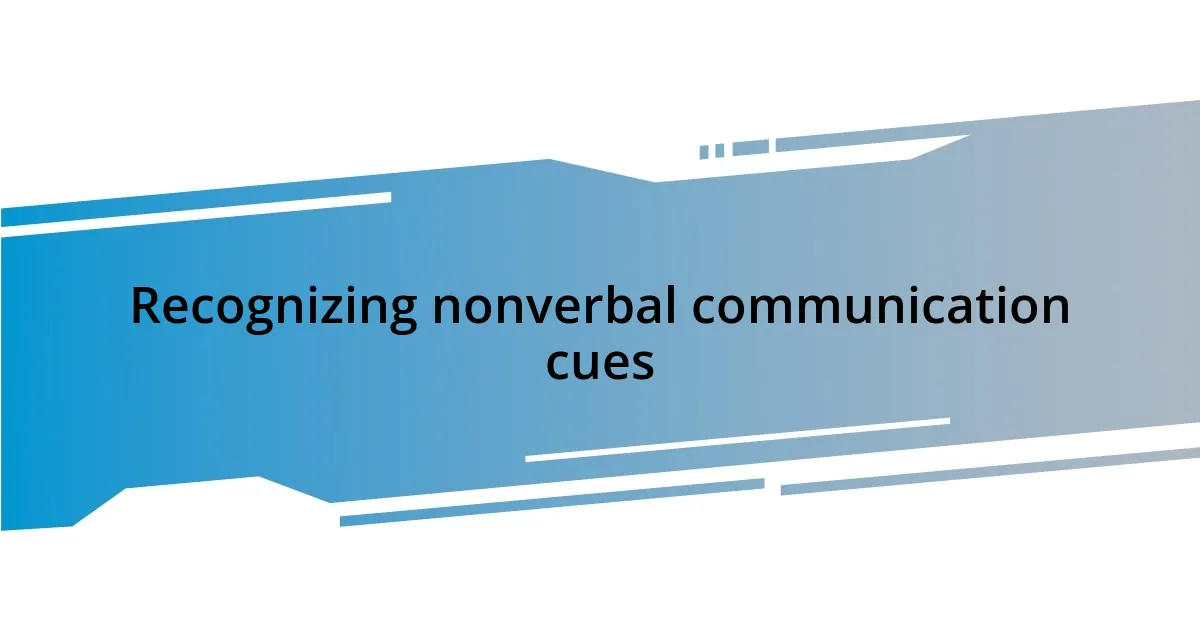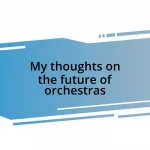Key takeaways:
- Conductors are both technical leaders and emotional guides, using gestures and body language to elicit a cohesive sound from musicians.
- Recognizing nonverbal cues, such as hand movements and body posture, is essential for understanding a conductor’s intentions and enhancing performance.
- Building rapport through open communication and mutual respect fosters a collaborative atmosphere, leading to improved musical synergy.
- Active listening and vulnerability in communication can transform rehearsals, allowing musicians to engage more deeply and express their insights effectively.

Understanding the role of conductors
Conductors play a pivotal role in shaping the musical experience. I remember attending a live orchestra performance for the first time; the way the conductor so fluidly directed the musicians felt almost like magic. How can one person influence so many artists to produce a cohesive sound? It’s fascinating to realize that conductors interpret the score through gestures, breathing life into the music with their unique vision.
As I’ve delved deeper into this subject, I’ve come to appreciate that conductors are not just technical leaders; they are also emotional guides. Witnessing a conductor’s ability to shift the energy in the room with a mere flick of the wrist left me in awe. Have you ever noticed how the mood of the orchestra can change dramatically with just a subtle cue? This balance of authority and empathy is crucial for drawing out the best performance from musicians.
The relationship between the conductor and the ensemble is almost like a conversation. During rehearsals, I observed how some conductors would engage with individual musicians, honing in on their strengths while gently nudging them to reach new heights. It is this rapport that creates an atmosphere of trust and collaboration. When I reflect on my learning journey, it’s clear that understanding how conductors communicate can profoundly impact how we, as musicians or listeners, engage with the music.

Recognizing nonverbal communication cues
Recognizing nonverbal communication cues is essential in understanding a conductor’s intentions. I once stood in a rehearsal where the conductor subtly shifted his weight; suddenly, the entire orchestra responded with a more focused sound. These brief moments are often more impactful than words.
Here are some critical cues to look out for:
- Hand Movements: A conductor’s hands can convey tempo, dynamics, and phrasing. For instance, a downbeat signals the start, while a subtle upward motion may indicate a crescendo.
- Facial Expressions: Emotions are often reflected in the conductor’s face. A raised eyebrow might suggest disbelief or surprise, while a bright smile can energize the orchestra.
- Body Position: Leaning forward can indicate urgency, while a relaxed stance might encourage a softer, more contemplative play.
- Eye Contact: A glance can serve as reassurance or a prompt for musicians to adjust their playing.
- Breathing: A conductor’s breath can set the pace, helping musicians synchronize their playing like a heartbeat.
These nuanced cues are often fleeting, but they weave a rich tapestry of expression that can transform a performance. One day, I watched a conductor seamlessly shift from joyful to somber merely with a change in posture. It was as if I could feel the music ebb and flow with him. Picking up on these cues not only helps in following directions but also deepens my appreciation for the art of conducting itself.

Establishing a clear communication style
Establishing a clear communication style with conductors was a transformative experience for me. In the beginning, I found myself overwhelmed by the variety of instructions conveyed through gestures and expressions. For example, when a conductor would pause before a particularly dynamic section, I learned that this moment was not just silence; it was a powerful invitation for the musicians to bring their energy and creativity into play. The shift from confusion to clarity in understanding these nuances made rehearsals much more engaging.
I realized that being proactive in communication was equally necessary. I remember a rehearsal where I raised my hand to ask the conductor a question about phrasing. The moment I spoke up, I felt an immediate connection, almost like a partnership. This openness significantly improved my understanding of the conductor’s intent and ultimately enhanced our collaboration. How could anyone thrive in such an intricate musical dialogue without a two-way exchange?
As I gained confidence, I began to appreciate the beauty of developing a mutual understanding with conductors. It’s like crafting a unique dialect—one that combines musical language with personal touch. Through my experiences, I learned that my body language and expression could complement the conductor’s signals, ensuring seamless communication. I often wonder, how many musicians miss this chance to connect on a deeper level? It’s a reminder that clear communication is not just about following cues but sharing a musical journey together.
| Aspect | Clear Communication |
|---|---|
| Importance | Essential for building rapport and trust |
| Strategy | Use both verbal and nonverbal signals |
| Outcome | Enhanced musical collaboration |

Developing active listening skills
Active listening is a game-changer in the realm of music collaboration. I remember a time during an intense rehearsal when the conductor paused, scanning the musicians with focused eyes. Instead of itching to break the silence, I leaned in, absorbing the weight of that moment. It hit me then that listening isn’t just about hearing; it’s about truly understanding the cues and emotions behind them. Why rush to fill a gap when valuable insights can emerge in the stillness?
As I honed my active listening skills, I discovered the art of reflection. In one memorable rehearsal, after a particularly complex section, I found the courage to paraphrase the conductor’s feedback back to him. I could see the relief on his face—an acknowledgment that I was on the same wavelength. This not only clarified my understanding but also created a sense of trust. Have you ever noticed how a simple nod or smile can strengthen the bond between a conductor and their musicians? It’s those small interactions that lay the foundation for a powerful musical synergy.
Interestingly, the more I practiced active listening, the more comfortable I became with vulnerability. I no longer felt afraid to express uncertainty or seek clarification. There was a rehearsal where I bravely admitted I didn’t quite grasp the desired tempo. The conductor’s response was not frustration but encouragement. He guided me through modifications, allowing me to contribute actively. I’ve learned that embracing openness transforms the listener’s role into an integral part of the musical conversation. How can we create beautiful music together if we’re not fully engaged?

Practicing effective rehearsal techniques
Practicing effective rehearsal techniques is crucial in building a seamless connection between conductors and musicians. I remember one particular rehearsal where we faced a complicated piece. The conductor demonstrated a specific tempo with an exaggerated gesture, and instead of merely following along, I decided to mimic that gesture back at him. This simple act of mirroring not only engaged the entire group but also fostered a collaborative atmosphere. Isn’t it fascinating how small, physical actions can significantly enhance group dynamics?
In my experience, the use of visualization can also be a powerful rehearsal technique. I often found that when rehearsing a particularly challenging section, I would close my eyes for a brief moment and picture the overall shape and movement of the music. During one practice, I shared this approach with the conductor, who was intrigued and encouraged us to visualize together as a group. That collective energy transformed our performance. I can’t help but ask, could visualization be the key that unlocks a deeper level of interpretation in ensemble work?
Finally, I realized that asking for feedback is a vital part of mastering rehearsal techniques. In one instance, after a particularly intense run-through, I felt the urge to share my thoughts about a specific moment. I didn’t hesitate to approach the conductor, expressing how a certainty about dynamic shifts could elevate our piece. The conversation that followed not only clarified my understanding but also reinforced my belief that open dialogue propels our musical journey forward. How many opportunities do we miss by not sharing our insights or concerns during rehearsals? Each discussion enriches our collective experience, reminding us that we are all part of a musical conversation.

Building rapport with conductors
Building rapport with conductors is about establishing trust and mutual respect. I recall my first performance with a new conductor; I was nervous, unsure of how to approach him. Instead of holding back, I decided to introduce myself beforehand and share a little about my musical background. To my surprise, he responded warmly, divulging his own experiences and insights. That initial connection transformed my feeling of anxiety into excitement, fostering an environment where open dialogue flourished.
Another aspect of building rapport is showing genuine interest in the conductor’s vision for the piece. I vividly remember a rehearsal when the conductor shared his interpretation of a challenging symphony. I expressed my enthusiasm about his approach, which led to a more collaborative atmosphere. When musicians actively engage with a conductor’s vision, it cultivates a sense of unity. Have you ever felt how sharing a common goal can energize a rehearsal? It’s incredible how that alignment can create a magnetic synergy on stage.
Equally important is the ability to express appreciation and support. After a particularly long rehearsal, I took a moment to thank the conductor for his patience and guidance. It’s remarkable how small gestures of gratitude can reinforce positive relationships. By acknowledging their efforts, we remind conductors that their work is valued. How often do we pause to reflect on the impact our words can have? That simple act made me realize we’re all in this together, striving for excellence as one cohesive unit.

Overcoming communication barriers
One of the biggest hurdles I faced was understanding the non-verbal cues from conductors. During one rehearsal, I noticed the conductor’s body language shifting drastically with the music’s dynamics. I realized that responding to these subtle signals was just as crucial as the notes on the page. How often do we overlook the power of body language in our exchanges? Embracing those gestures not only improved our synchronization but also made me feel more connected to the conductor’s vision.
Another barrier I encountered was combating the nerves that often came with communicating under pressure. I remember standing on stage before a performance, overwhelmed with thoughts, unable to articulate my concerns. In that moment, I chose to take a deep breath and seek eye contact with the conductor. Surprisingly, that simple connection opened up a channel for me to express my thoughts clearly. Have you ever realized the difference a calm moment can make in fostering understanding? This experience taught me that vulnerability can turn a stressful situation into an opportunity for collaboration.
Moreover, I found that actively listening was key to overcoming misunderstandings. At one point, a conductor provided feedback that initially sounded critical to me. Instead of reacting defensively, I paused and truly listened to his intentions. This shift changed my perspective, as I began to recognize his passion for clarity and excellence. How often do we misinterpret feedback because we’re too caught up in our emotions? This awareness helped me create a more open dialogue with conductors, encouraging growth and synergy in our rehearsals.
















